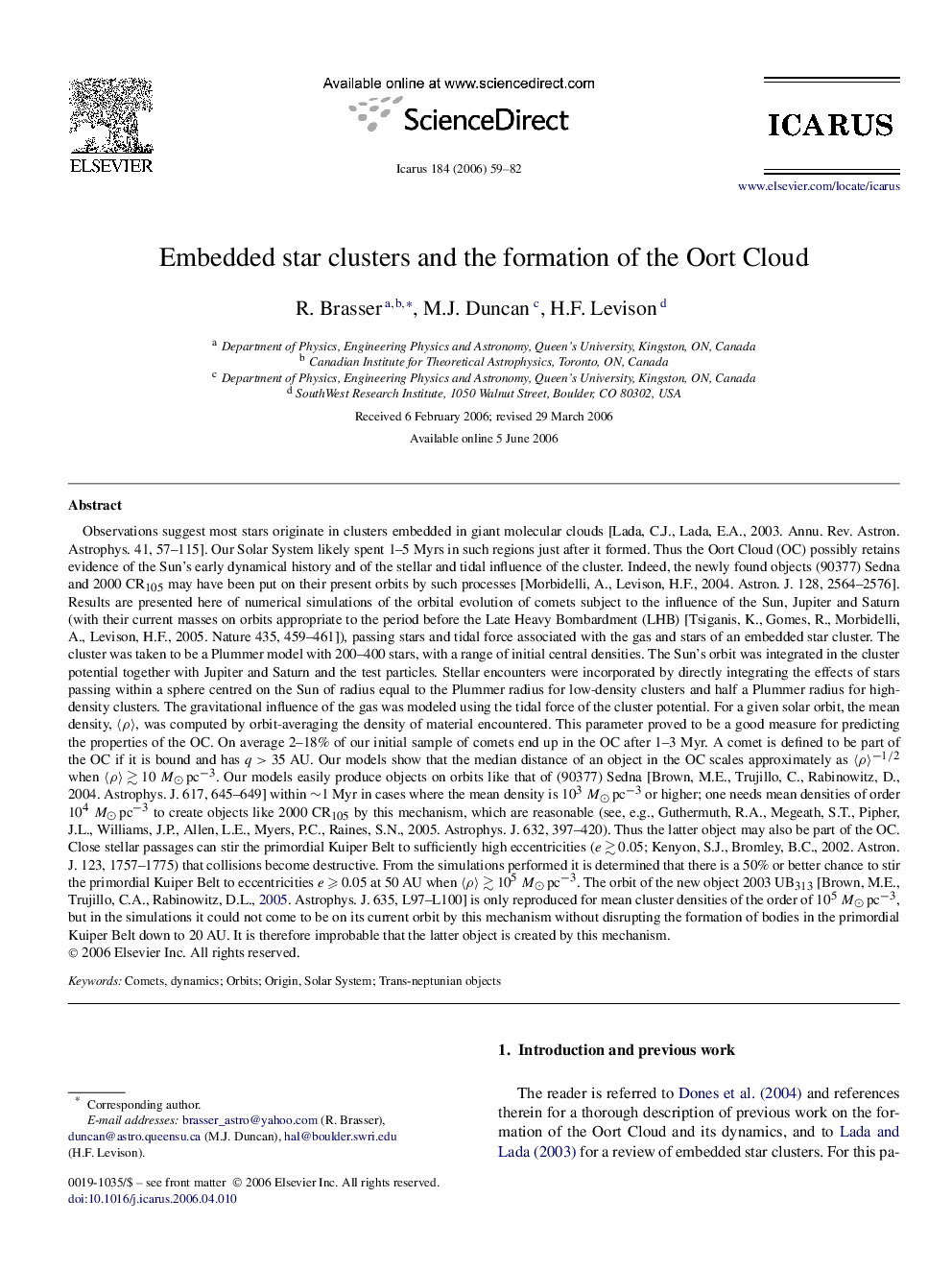| کد مقاله | کد نشریه | سال انتشار | مقاله انگلیسی | نسخه تمام متن |
|---|---|---|---|---|
| 1775971 | 1021213 | 2006 | 24 صفحه PDF | دانلود رایگان |

Observations suggest most stars originate in clusters embedded in giant molecular clouds [Lada, C.J., Lada, E.A., 2003. Annu. Rev. Astron. Astrophys. 41, 57–115]. Our Solar System likely spent 1–5 Myrs in such regions just after it formed. Thus the Oort Cloud (OC) possibly retains evidence of the Sun's early dynamical history and of the stellar and tidal influence of the cluster. Indeed, the newly found objects (90377) Sedna and 2000 CR105 may have been put on their present orbits by such processes [Morbidelli, A., Levison, H.F., 2004. Astron. J. 128, 2564–2576]. Results are presented here of numerical simulations of the orbital evolution of comets subject to the influence of the Sun, Jupiter and Saturn (with their current masses on orbits appropriate to the period before the Late Heavy Bombardment (LHB) [Tsiganis, K., Gomes, R., Morbidelli, A., Levison, H.F., 2005. Nature 435, 459–461]), passing stars and tidal force associated with the gas and stars of an embedded star cluster. The cluster was taken to be a Plummer model with 200–400 stars, with a range of initial central densities. The Sun's orbit was integrated in the cluster potential together with Jupiter and Saturn and the test particles. Stellar encounters were incorporated by directly integrating the effects of stars passing within a sphere centred on the Sun of radius equal to the Plummer radius for low-density clusters and half a Plummer radius for high-density clusters. The gravitational influence of the gas was modeled using the tidal force of the cluster potential. For a given solar orbit, the mean density, 〈ρ〉〈ρ〉, was computed by orbit-averaging the density of material encountered. This parameter proved to be a good measure for predicting the properties of the OC. On average 2–18% of our initial sample of comets end up in the OC after 1–3 Myr. A comet is defined to be part of the OC if it is bound and has q>35 AUq>35 AU. Our models show that the median distance of an object in the OC scales approximately as 〈ρ〉−1/2〈ρ〉−1/2 when 〈ρ〉≳10 M⊙pc−3. Our models easily produce objects on orbits like that of (90377) Sedna [Brown, M.E., Trujillo, C., Rabinowitz, D., 2004. Astrophys. J. 617, 645–649] within ∼1 Myr in cases where the mean density is 103 M⊙pc−3 or higher; one needs mean densities of order 104 M⊙pc−3 to create objects like 2000 CR105 by this mechanism, which are reasonable (see, e.g., Guthermuth, R.A., Megeath, S.T., Pipher, J.L., Williams, J.P., Allen, L.E., Myers, P.C., Raines, S.N., 2005. Astrophys. J. 632, 397–420). Thus the latter object may also be part of the OC. Close stellar passages can stir the primordial Kuiper Belt to sufficiently high eccentricities (e≳0.05e≳0.05; Kenyon, S.J., Bromley, B.C., 2002. Astron. J. 123, 1757–1775) that collisions become destructive. From the simulations performed it is determined that there is a 50% or better chance to stir the primordial Kuiper Belt to eccentricities e⩾0.05e⩾0.05 at 50 AU when 〈ρ〉≳105 M⊙pc−3. The orbit of the new object 2003 UB313 [Brown, M.E., Trujillo, C.A., Rabinowitz, D.L., 2005. Astrophys. J. 635, L97–L100] is only reproduced for mean cluster densities of the order of 105 M⊙pc−3, but in the simulations it could not come to be on its current orbit by this mechanism without disrupting the formation of bodies in the primordial Kuiper Belt down to 20 AU. It is therefore improbable that the latter object is created by this mechanism.
Journal: Icarus - Volume 184, Issue 1, September 2006, Pages 59–82